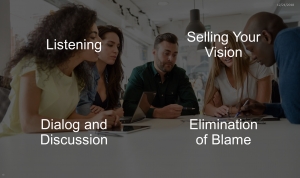Todd Williams
People vs Process Track Session/Keynote Example
If you want educational keynote many of our presentations can be keynotes or track sessions. In the example below, the presentation People or Process: Which Impacts Project Success More? is given as a track session.
Example People vs Process keynote as a track session
This session was given at the PMI Sioux Empire Professions Development Day help in Sioux Falls SD on September 9, 2014.
Webinar Topic Example
Nearly any topic that Todd Williams writes about or speaks on, he can do a webinar. You can find some of his "uni-directional" webinars on ProjectManagement.com (see partial listing below) or you can have a fully interactive session as in the audio clip. The limitations of the session are based on the tool used. In this example, the ZOOM meeting tool was used and it did not allow recording of the video. The session was recorded on May 29, 2019 at 12:30PM London time (4:30AM Pacific). There were about a dozen people online, about half of them had their video turned on, and the meeting organizer (Jonathan Norman) moderated the call.
What Example Webinar: Eliminating Blame Covers
Here are three uni-directional webinar examples posted on ProjectManagement.com (these are free to PMI Members)
Visualizing Change Example
Visualizing Change presentations have the impact of physicalizing inanimate objects and events. They are fun and involve many of the people in the workshop or presentation. In general, it is easy to get people interested in attending since mentioning that there are rope, chains, whips and blindfolds have a tendency to pique people's interest. But don't worry, as you will see from the video, this is a child-friendly event. The props physicalize constraints, chains of command, slave drivers, ignorance, and the like.
Many discussions are held ahead of the event to ensure that the correct issues are addressed. This presentation can model nearly any problem or change by helping define the current and future states in a very jocular and interactive manner.
Visualizing change presentations and workshops cannot be done online.
Visualizing Change Example
What Would You Do? Presentation Example
The What Would You Do? series of presentations have two goals: 1) educate the audience, and 2) get them involved with developing an answer. They are built on the premise that any audience has a wealth of knowledge and that we need to get away from the talking-head and engage the attendees. The example below is the presentation $305 Million Failure (At the time of this presentation, since it was still in litigation, it was only a $250 Million Failure). There are also ready-made presentations on sponsorship, ethics, and change management. If there is another topic you would like to see, please let us know.
What Would You Do? example ($305 Million Failure)
Vision to Value Track Session/Keynote Example
If you want educational keynote many of our presentations can be keynotes or track sessions. In the example below, the presentationVision to Value: Executing Strategically Focused Initiatives is given as a track session. This video shows the flexibility to work with the audience in ways that generally cannot be done in keynotes.
Example Vision to Value keynote as a track session
This session was given at the 2014 Instant impact Conference hosted by PMI Olympia on September 5, 2014. It was given twice that day. This is the afternoon session.
Extreme Leadership Keynote Example
Keynotes set the tone for a conference, a day, or give people the ability to pull all of the events from the day together into culminating thought. We offer inspirational, leadership, and technical keynotes. Our flagship keynote is Extreme Leadership and is the example for our keynotes
Extreme Leadership is a multifaceted keynote fully customizable to your event. It highlights the following aspects of leadership:
- Leadership is a journey.
- Leadership is dynamic. You need different approaches to nearly every situation.
- Leadership does not need authority. It is not a title. It is something you earn.
- Leaders have positive attitudes regardless of the situation.
- Leadership does have core technical traits that, as individuals, we can develop. While other traits based on our personalities and are much hard to change.
- There are leadership passages that we must go through that define who we are as leaders. These may be work-based—a new job, stretch goal assignments, being fried, etc.) or personal (Severe illness, death of a loved one, etc.). These passages are learning events. How we handle them determines what type of leader we become.
This version of Extreme Leadership is customized for PMI Northern Utah's 750 attendees in the following way:
- The audience is all project managers
- The event organizer, Liz Price, had a theme of STEAM (Stories That Enliven and Motivate) she was developing and needed a central message to inspire people on the longest day of their three-day event.
Extreme Leadership motivational keynote
Transform Your Project Leadership: For Professionals Leading Projects or Company Initiatives
Todd Williams contributed Chapter 7, "Leaders Listen." You can buy it on Amazon.
More coming soon!
Filling Execution Gaps: How Executives and Project Managers Turn Corporate Strategy into Successful Projects
What Filling Execution Gaps Covers
Filling Execution Gaps
by Todd C. Williams
ISBN: 978-1-5015-0640-6
De G Press (DeGruyter), September 2017
Project alignment, executive sponsorship, change management, governance, leadership, and common understanding. These six business issues are topics of daily discussions between executives, middle management, and project managers; they are the pivotal problems plaguing transformational leadership. Any one of these six, when improperly addressed, will hex a project's chances for success. And, they do—daily—destroying the ability companies to turn vision into value.
|
Check it out on Amazon or the Filling Execution Gaps website |
Without the foundation of a common understanding of goals and core concepts, such as value being critical to success, communication stops and projects fail.
Without change management, users fail to adopt project deliverables, value is lost, and projects fail.
Without maintaining alignment between corporate goals and projects, projects miss their value targets and projects fail.
Without an engaged executive sponsor, scope increases, goals drift, chaos reigns, value is lost, and projects fail.
Without enough governance, critical connections are not made, steps are ignored, value is overlooked, and projects fail.
Too much governance slows progress, companies cannot respond to business pressures, value drowns in bureaucracy, and projects fail.
Without strong leadership defining the vision and value, goals are not set, essential relationships do not form, teams do not develop, essential decisions are not made, and projects fail.
Filling Execution Gaps: Building Success-Focused Organizations
.gif)
Executives define vision, strategy, and goals to advance the business. Projects enable companies to meet those goals. Between strategy and projects, there is a lot of work to be done—work that lays the foundation for project and operational success. Through experience and research, six common gaps exist in organizations that inhibit project success—an absence of common understanding, disengaged executive sponsors, misalignment with goals, poor change management, ineffective governance, and lackluster leadership.
Get Recognized as a Leader: Four Core Leadership Actions
.gif)
Leaders make decisions. This requires a core set of actions to gather the best information, hear out the concerns of others, and making a decision that everyone will follow—even if there is not unanimous agreement with the decision. Although there are hundreds of actions leaders must take, there are four core actions that all great leaders do—listening, dialog and discussion, selling a vision, and eliminating blame. This session will discuss those actions in a roundtable format that we call a "What Would You Do?" session. In these sessions, the presenter acts as a moderator spending 10 to 15 minutes per topic working with the audience talking about what the action is, how to best do it, and hearing from the group on how they have carried out the action. This brings significant audience interaction, involvement, and broader education.
.png)
 Twitter
Twitter Facebook
Facebook RSS
RSS Linkedin
Linkedin


